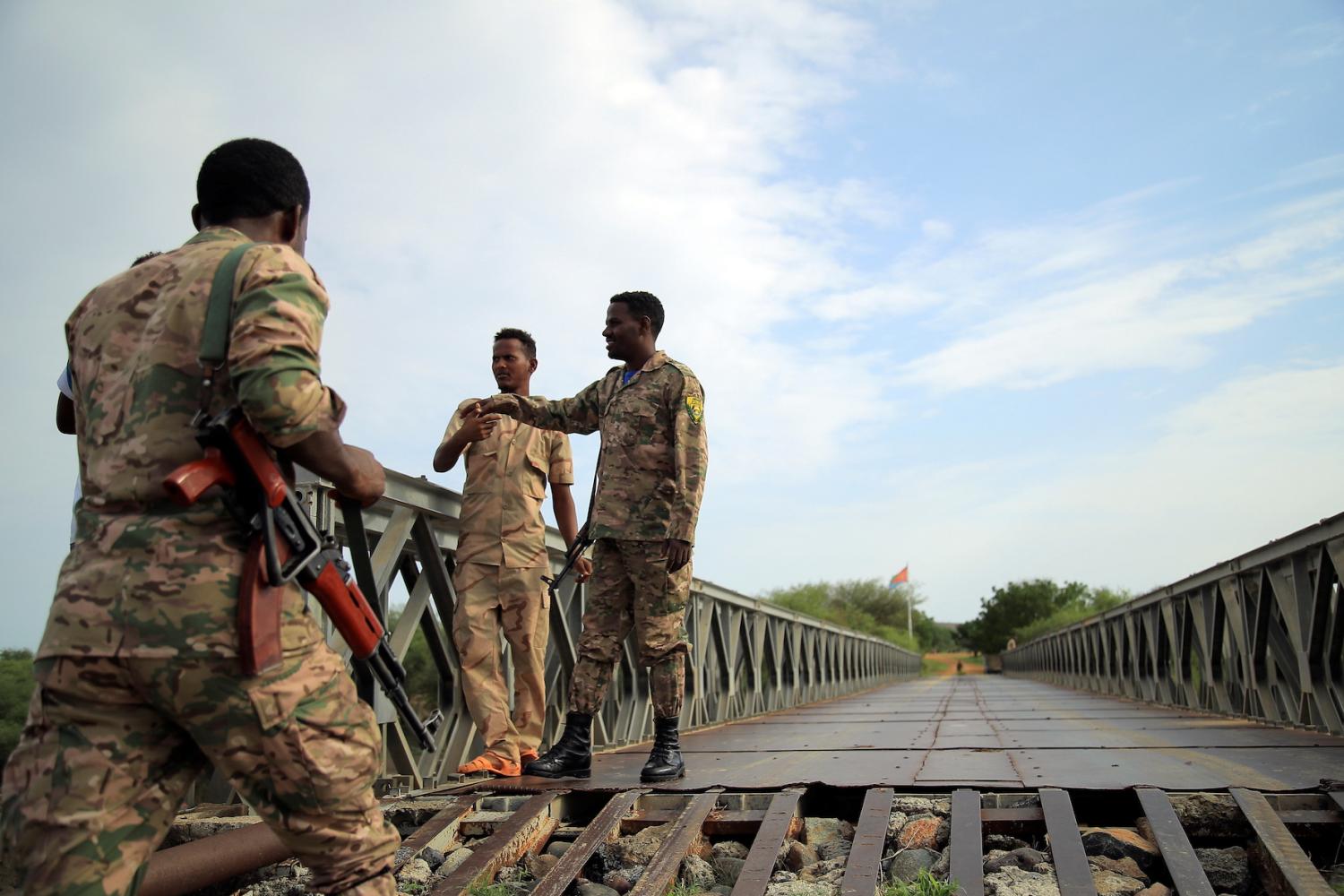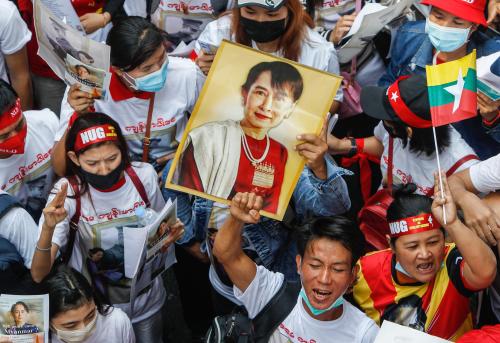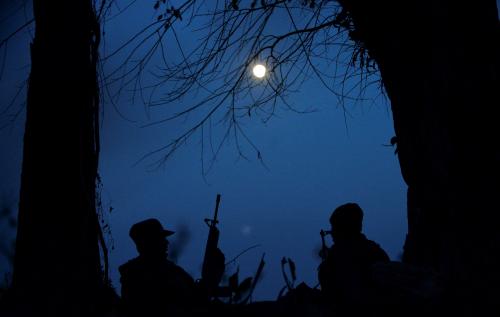This piece is part of a series titled “Nonstate armed actors and illicit economies in 2024” from Brookings’s Initiative on Nonstate Armed Actors.
The third anniversary of the February 2021 coup d’état in Myanmar is quickly approaching. For the past three years, the people of Myanmar have faced intense and widespread violence, civil unrest, and a crumbling economy under the rule of the military junta and its State Administration Council (SAC). The government in exile — the National Unity Government (NUG) — has led and partnered with local resistance forces inside Myanmar, including the People’s Defense Force (PDF) and ethnic armed organizations (EAOs), to battle against the SAC. Despite the junta’s repeated, brutal counterinsurgency operations against civilians, by 2022, many observers assessed that the armed conflict had stalled.
However, by the end of 2023, the stalemate appeared to be upended. In late October, three anti-junta EAOs significantly pushed back the Burmese military in the country’s northern areas. Some Myanmar watchers believe that the balance of power may shift sufficiently to change the tides within the country or the military government, even if it is premature to predict the collapse of the SAC.
Operation 1027
On October 27, 2023, the Three Brotherhood Alliance (3BTA), composed of the Arakan Army, Myanmar National Democratic Alliance Army, and Ta’ang National Liberation Army and numbering some 15,000 fighters, launched Operation 1027, an anti-SAC offensive in Shan State. The offensive captured significant territory bordering China. The 3BTA had been preparing for this offensive for years, according to local interlocutors, and its forces were equipped with advanced weapons, including drones acquired on foreign markets. The 3BTA has had diverse funding sources, including donations, assistance from other ethnic organizations, trade and tax revenues from territories under its control, as well as alleged illicit activities.
Although the three organizations assert their goal is the “overthrowing of the military dictatorship,” most analysts see their primary goal as local territorial gains, especially capturing Kokang from the local government supported by the SAC. Their success in resource-rich northern Shan has delivered a military and economic blow to the junta, but it remains to be seen whether it is significant enough to break the regime’s grip on power.
Nonetheless, Operation 1027 stimulated unprecedented coordination and unity among the resistance forces. Synchronized collective campaigns targeting the military government emerged across the country, and the military’s control has been shaken, its resources strained, and the morale of its soldiers undermined, leading to more defections.
These dynamics have strengthened the willingness of the disparate and highly fractious EAOs and resistance groups to cooperate more extensively to increase their strategic leverage. Even outright rivals are exhibiting an inclination toward unity, at least temporarily. For example, on November 29, two ethnic Shan militias — the Shan State Progressive Party/Shan State Army and the Restoration Council of Shan State/Shan State Army — agreed to a truce and future unification after a trust-building period.
The Burmese military’s power has been diminished throughout the years. By the early 2000s, it was estimated that the military had grown to about 400,000 service personnel. By May 2023, the United States Institute of Peace estimated the size of the military had fallen by more than half to around 150,000 personnel, including 70,000 combat soldiers. Casualties and defections have affected the military significantly, although it still monopolizes airpower as well as heavy artillery. The military has deployed both with no regard for civilian casualties.
Fearful of the resistance’s attacks in lower Myanmar, especially in the heartland of the Bamar territory, the Burmese military has prioritized air strikes against the EAOs. Highly indiscriminate and augmenting civilian suffering, they cause damage to the EAOs but are insufficient to help the junta reestablish territorial control in the north. The junta still enjoys revenues from domestic sources and foreign trade. Between the Feb 2021 coup and May 2023, it had imported more than $1 billion worth of weapons, according to a United Nations investigation.
China’s (limited) change of heart
A key factor that contributed to Operation 1027’s success has been China’s tacit approval. China had been frustrated with the growing cyber-scam operations along the China-Myanmar border that targeted Chinese nationals, even enslaving thousands of them. According to local interlocutors, many of the operations have been run by border militias and local actors linked to the junta, and the junta has been receiving lucrative payoffs from them.
Though long implicated in various illicit economies, 3BTA’s vow to eradicate the cyber-scam operations catered to China’s urgent demands. Indeed, since the 3BTA’s capture of Kokang, most of the cyber-scam operations there have been shut down, not the least because China cut off power supplies to Kokang. Other EAOs, such as the United Wa State Army, a major actor in methamphetamine production, have also shut down cyber-scam operations on their territory. By November 21, 31,000 criminals and Chinese nationals had been sent back to China, according to the Chinese Ministry of Public Security.
Yet the escalation in northern Shan also worries China. 3BTA claims to have captured several towns as well as the Kyin-San-Kyawt border crossing, one of the five major trade zones between Myanmar and China. The Myanmar National Democratic Alliance Army additionally claims that the resistance has liberated four Shan ports of entry to China (Qingshui River Port, Menggu National Gate, Bangsai Port, and Muse Golden Triangle Port). However, Chinese businesses in Myanmar are being negatively impacted by reported delays in receiving raw materials from China and are expressing concerns about losses of revenue as the offensive moves south. Before the offensive and its capture by 3BTA, the Chinshwehaw township alone accounted for more than one-quarter of the $1.8 billion in cross-border trade between the two countries.
Thus, there are limits to China’s willingness to punish the Myanmar junta, and not only due to economic concerns. Until now, the 3BTA offensive has not provoked significant refugee flows into China. Should that change, China will start pushing for a speedy cease-fire even if it requires a more heavy-handed Chinese approach toward the 3BTA. Moreover, Beijing’s tacit approval for Operation 1027 is not a blank check for the resistance to overthrow the military government. As China does not believe that the Burmese military can be eliminated from Myanmar’s domestic politics, it sees a negotiated settlement as the only solution to the country’s turmoil.
Implications for 2024
With or without China, there is no chance that the SAC will come out of Operation 1027 on top. It has lost major territory and posts in northern Myanmar.
But the SAC is not collapsing either. In lower Myanmar and in critical locations where the military has focused its troops and resources, there is no sign that the SAC will willingly give up control, negotiate with the resistance, or be rapidly defeated by it. The momentum in the stalemate has shifted — at least for a while — in the resistance’s favor, but the shift is insufficient to change the power equilibrium to the point that the SAC makes critical concessions or collapses. Only further significant military attrition would drive the SAC to a negotiated settlement. The momentum set off by Operation 1027 would have to endure, expand, and escalate to bring about such a change.
The challenge for U.S. policy is evident. It is clear that the resistance needs more external support. However, with the resistance fragmented between and among the Bamar democratic opposition and the ethnic armed organizations, it will be difficult for policymakers in Washington to effectively address the lack of capacity and the differences within the resistance. The 2023 National Defense Authorization Act included potential provisions of non-lethal support to the resistance, which has not transpired as of today. The lack of a widely accepted and legitimate organizational structure within the resistance is one of the primary causes. While direct financial or military support will be difficult, focused capacity-building to strengthen the resistance’s organization and cohesion is still urgently needed.
Although Myanmar was supposed to chair the Association of Southeast Asian Nations (ASEAN) in 2026, the organization’s leaders have reportedly barred it from the chairmanship due to the country’s ongoing conflict. Nevertheless, many of ASEAN’s member states are deeply divided over Myanmar’s domestic turbulence and have given up the hope that ASEAN could develop an effective and unanimous position on the conflict. However, the United States should endeavor to continue shaping ASEAN’s approach, or at a minimum, the approach by the more like-minded ASEAN members to increase pressure on Myanmar’s junta to change its policies.
Operation 1027 has unleashed important momentum to break the stalemate and bring along future changes in Myanmar. But now, more is needed, both from outside and within.
The Brookings Institution is committed to quality, independence, and impact.
We are supported by a diverse array of funders. In line with our values and policies, each Brookings publication represents the sole views of its author(s).








Commentary
Operation 1027: Changing the tides of the Myanmar civil war?
January 16, 2024